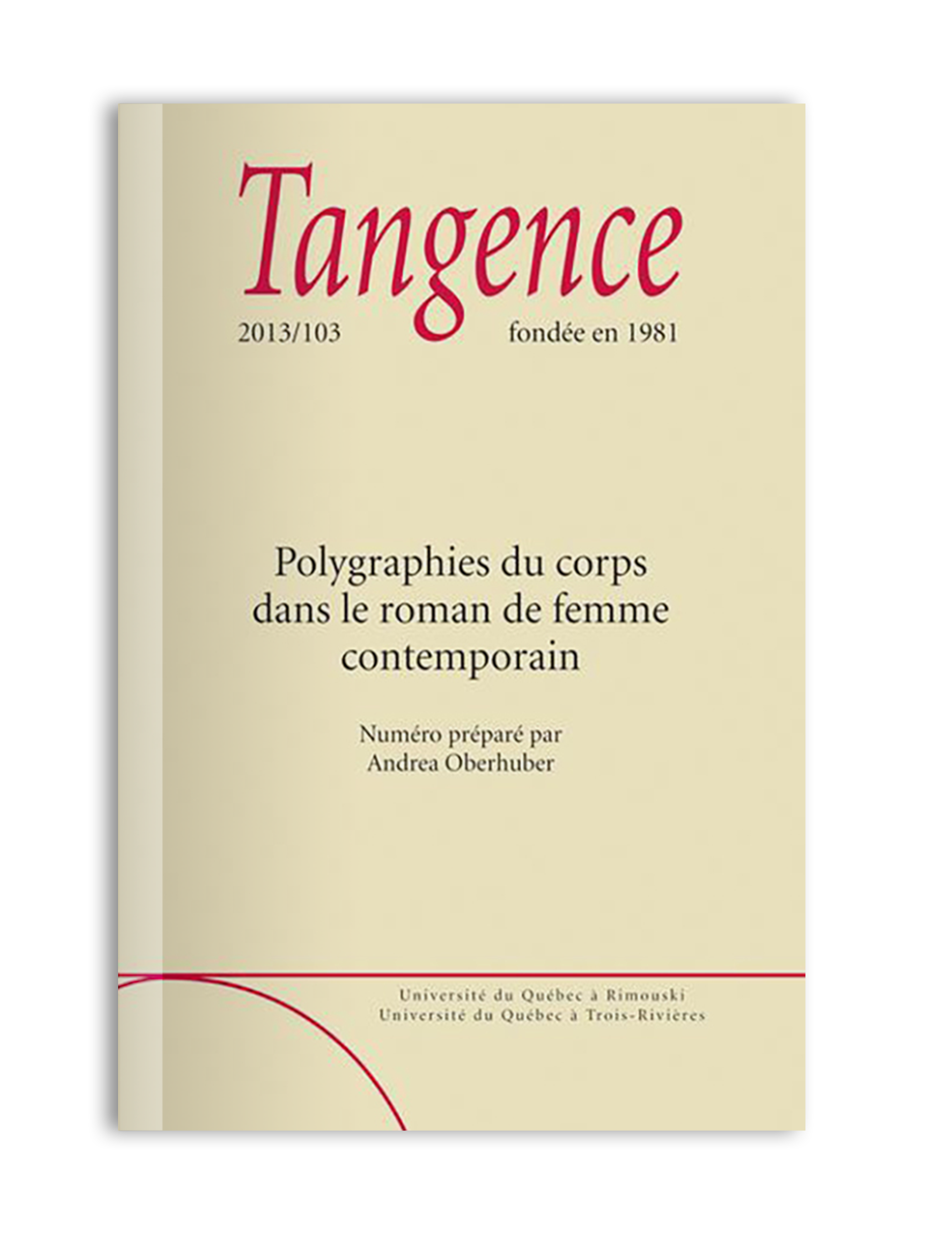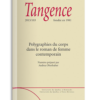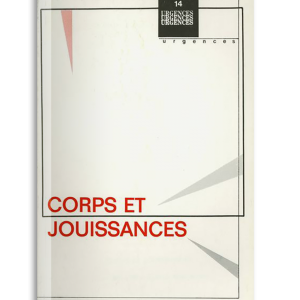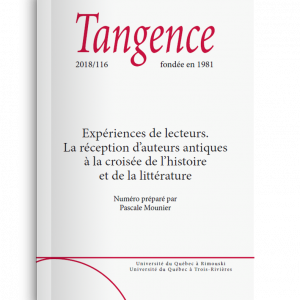N° 103 / 2013
Polygraphies du corps dans le roman de femme contemporain
Andrea Oberhuber
Dans le corps du texte
L’œuvre conçue comme « encyclopédie », pour préciser l’idée polygraphique évoquée dans Roland Barthes par Roland Barthes, sert de réceptacle aux idées ainsi qu’aux « objets disparates » (de savoir, de sensualité) placés non dans l’ordre mais dans le désordre faisant fi du (trop) rationnel et de l’homogène. Le syntagme « polygraphies du corps » est censé mettre le lecteur sur la piste d’une conception du corps mise sous le signe du multiple, présidant à la réflexion sur un contenant-contenu qui, au fond, est un matériau de création : dans sa double appréhension, le corps se manifeste dans et par l’écriture, de diverses manières.
Écrire, décrire, inscrire : trois moments de réflexion qui me permettront de circonscrire les contours du dossier « Polygraphies du corps dans le roman de femme contemporain ». À travers ces trois verbes à l’infinitif signalant le processus d’une pensée plutôt qu’un état de fait, il s’agira de répondre à un certain nombre de lieux communs en ce qui a trait à diverses formes d’imbrication du corps et de l’écriture des femmes, tout en insistant sur l’idée du corps — physique et textuel — comme espace perméable par lequel le sujet entre en résonance avec l’en-dehors.
In the Body of the Text
The polygraphic concept evoked in Roland Barthes par Roland Barthes, that of the œuvre conceived as an “encyclopedia”, serves as a repository for ideas as well as for “disparate objects” (of knowledge, of sensuality) that are not ordered but that exist in a kind of disorder that scorns what is (too) rational or homogeneous. The phrase “polygraphies of the body” should lead the reader towards an understanding of the multiple body, calling for reflection about a contained-container which is, essentially, material for creation : in its double meaning, the body manifests itself in and through writing in numerous ways.
To write, to describe, to inscribe : these three points of reflection will allow me to define the contours of the dossier “Polygraphies du corps dans le roman de femme contemporain.” Signifying the process of thinking rather than designating an established fact, these three verbs in the infinitive tense will serve as a means to question commonly accepted ideas regarding the entanglement of the body and women’s writing, all the while insisting that the physical and textual body is a permeable space in which the subject enters into resonance with the outside.
***
Martine Reid
En-corps, brèves observations sur le manifeste d’Hélène Cixous
On ne saurait comprendre le sens et la portée du Rire de la Méduse d’Hélène Cixous sans prendre en compte d’abord le singulier rapport qu’il établit, dès sa parution en 1975 dans la revue L’Arc, avec les positions de Simone de Beauvoir. On ne saurait ensuite lui donner toute sa force sans rappeler, en parallèle avec les positions de Beauvoir toujours, les filiations qu’il relie aux écrits de certaines femmes auteurs du passé.
En-corps, brief observations on Hélène Cixous’s manifesto
The meaning and significance of Hélène Cixous’s The Laugh of the Medusa cannot be understood without first taking into account the singular relationship it established, from its publication in 1975 in the journal L’Arc, with the positions of Simone de Beauvoir. And its full power cannot be grasped without recalling, still in connection with de Beauvoir’s positions, the links it creates to the writings of certain female authors from the past.
***
Sofiane Laghouati
Les je(ux) de partitions d’Assia Djebar : un Quatuor algérien pour corps féminins
L’amour, la fantasia (1985), Ombre sultane (1987) et Vaste est la prison (1994) sont les trois premiers opus d’une tétralogie, toujours en devenir, de l’écrivaine algérienne Assia Djebar. Ils s’inscrivent dans un second cycle d’œuvres, fascinant tant par leur architecture narrative et l’invention stylistique que par la place singulière qu’elles concèdent à des corps tenus habituellement au secret, parce que féminins. Ces polygraphies des corps que propose l’écrivaine sont à envisager non seulement à partir des interdits desquels elles émergent — au creuset de l’histoire personnelle ou au carrefour des destinées collectives —, mais aussi pour ce qu’elles mettent en perspective.
Assia Djebar’s music scores : a quartet for female bodies
Fantasia : An Algerian Cavalcade (1985), A Sister to Scheherazade (1987) and So Vast the Prison (1994) are the three first novels of a tetralogy, still in progress, by the Algerian writer Assia Djebar. They fall within a second cycle of works, fascinating as much for their narrative architecture and stylistic invention as for the singular place they accord to bodies habitually relegated to the background because they are female. These body polygraphs proposed by the author are to be considered not only in relation to the prohibitions from which they emerge — in the crucible of personal history or at the crossroads of collective destinies —, but also for what they put into perspective.
***
Catherine Mavrikakis
Le corps de la filiation : répétitions et détournements de l’Histoire des femmes dans le roman Purge de Sofi Oksanen
Cet article veut penser la place de la répétition dans la constitution d’une filiation féminine où le corps agit comme espace commun entre les générations. Le roman Purge de Sofi Oksanen, prix Femina étranger en 2010, montre que le corps des femmes a payé le prix du déroulement de l’Histoire estonienne et que c’est sur la chair féminine que s’écrivent les répétitions et bouleversements sanglants. Entre une grand-tante qui a vécu le communisme, ses humiliations et ses viols et une petite-nièce qui se prostitue en Allemagne en étant battue, maltraitée et poursuivie par des proxénètes russes, le roman établit un écho étrange. Le corps féminin pour Oksanen est pensé comme répétition mortifère. Ce sont les reprises de l’histoire qui s’inscrivent sur la vieille femme Aliide et la jeune fille Zara. Comment sortir de cette structure de domination où les corps des femmes se parlent silencieusement dans leurs souffrances ? Par quels moyens donner à Zara la possibilité de ne pas avoir le corps blessé de l’Histoire ?
The body of the filiation : repetitions and reversals of history experienced by women in the novel Purge by Sofi Oksanen
This article proposes to examine the place of repetition in the constitution of a female filiation where the body acts as a common space between generations. Sofi Oksanen’s novel Purge, winner of the Prix Femina Étranger in 2010, shows that women’s bodies have paid the price of the development of Estonian history, and that its bloody repetitions and upheavals have left their mark on female flesh. Between a great aunt who lived under Communism, her humiliations and rapes, and a great-niece who works as a prostitute in Germany while being beaten, abused and pursued by Russian procurers, the novel creates a strange echo. Oksanen views the female body as a deadly repetition. The rallies of history are recorded on the old woman Aliide and the young girl Zara. Is there any way out of this structure of domination where women’s bodies speak silently to each other in their suffering ? In what ways can Zara be offered the possibility of a body unscarred by History ?
***
Martine Delvaux
Écriture et nudité. Les femmes de Nelly Arcan et Vanessa Beecroft
Cet article se penche sur la question de l’image de la femme, de la femme comme image dans le regard des hommes (suivant la lecture de John Berger). L’œuvre de la photographe américano-italienne Vanessa Beecroft et les romans de Nelly Arcan servent ici de matériaux pour réfléchir à la peau et à la nudité comme seuil de la femme-image : lieu où le regard masculin accroche, mais surface qui permet aux femmes de résister.
Writing and nudity. The women of Nelly Arcan and Vanessa Beecroft
This article focuses on the question of the image of woman, of woman as image in the male gaze (based on a reading of John Berger). The work of the American Italian photographer Vanessa Beecroft and the novels of Nelly Arcan serve here as materials for reflecting on skin and nudity as the threshold of woman as image : the place to which the male gaze attaches, but a surface that allows women to resist.
***
Florence de Chalonge
Le corps dans la voix. De L’amour à L’homme assis dans le couloir de Marguerite Duras
Entre L’amour, paru en 1971, et L’homme assis dans le couloir de 1980, Marguerite Duras s’est consacrée à l’écriture filmique. Dissociant corps et voix, la cinéaste a profondément modifié sa poétique du personnage. Dans le cinéma de l’auteure, la vie du corps laisse sans voix, tandis que la voix du dialogue ou du récit est désincarnée. Là où, dans L’amour, les personnages hébétés se tenaient à distance les uns des autres et livraient à une énonciation impersonnelle leurs corps morts au désir, l’érotique de L’homme assis expose les corps à la mort sous le regard d’une première personne qui vient en témoigner. Si la triangulation est toujours la mathématique élémentaire de la fable, avec L’homme assis, le dispositif énonciatif donne désormais à l’auctorialité durassienne, pour reprendre le mot de Barthes, un corps dans la voix.
The body in the voice. From L’amour to The Man Sitting in the Corridor by Marguerite Duras
Between L’amour, published in 1971, and The Man Sitting in the Corridor published in 1980, Marguerite Duras dedicated herself to writing for film. Dissociating body and voice, the film writer profoundly modified her poetics of character. In the author’s films, the life of the body leaves one speechless, while the voice of the dialogue or the narrative is disembodied. Whereas, in L’amour, dazed characters maintain a distance from each other and express their affectlessness through impersonal speech, the eroticism of the Man Sitting in the Corridor exposes bodies to death under the gaze of a first person who comes to witness it. If triangulation remains the elementary mathematics of the fable, with The Sitting Man, speech arrangement henceforth gives Durassian authoriality, to borrow the words of Barthes, a body in the voice.
***
Marie-Dominique Garnier
Corps calliens : suite deleuzienne (nom, corps, nomos)
Une femme de « chambre », dans L’Hôtel et Suite vénitienne, s’en prend aux clichés par le biais du cliché : par la photographie, sur fond de chambre hôtelière autant que photographique. Engins de résistance au prépensé, les « suites » de Sophie Calle (filatures, pièces, séries d’images) y occupent le dedans autant que le dehors. Parmi les idées reçues que déconstruit Sophie Calle figurent le corps, ses limitrophies, ses accessoires. Un corps peut être d’autant mieux photographié qu’il n’est pas là. La vue peut n’exister qu’à devenir toucher. Un corps peut entrer en phase de production floue d’un coup de nom. D’ailleurs, qu’est-ce qu’un corps, qu’est-ce qu’un nom, lorsque celui-ci a pour traduction ou doublure l’espace public de la rue, calle, en italien ? À partir de concepts empruntés à Deleuze et Guattari (nomos, ligne de fuite), la lecture prend le chemin théorique de « lignes de suite » : déambulations qui fondent la pratique nomade de Sophie Calle et de ses chambres courbes.
Calle’s bodies : Deleuzian pursuit (name, body, nomos)
A “chamber” maid, in L’Hôtel and Suite vénitienne, fights clichés with cliché : by means of photography, using both a backdrop of hotel rooms and a view camera. Engines of resistance to assumptions, the “suites” of Sophie Calle (acts of stalking, rooms, series of images) are present both inside and outside the room. Among the received ideas Sophie Calle deconstructs are the body, its boundaries, its accessories. A body can be photographed all the better when it’s not there. Sight can only exist by becoming touch. A body can enter a hazy production phase with the stroke of a name. Moreover, what is a body, what is a name, when its translation or stand-in is the public space of the street, calle, in Italian ? Using concepts borrowed from Deleuze and Guattari (nomos, line of flight), the reading takes the theoretic path of “lines of flight” : wanderings that underlie Sophie Calle’s nomadic practice and curved hotel rooms.






